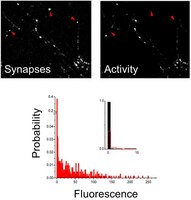Functional mapping of brain synapses by the enriching activity-marker SynaptoZip
Mattia Ferro 1 2 , Jacopo Lamanna 1 2 , Maddalena Ripamonti 1 2 , Gabriella Racchetti 1 3 , Alessandro Arena 1 2 4 , Sara Spadini 1 2 , Giovanni Montesano 1 2 5 , Riccardo Cortese 6 , Vincenzo Zimarino 2 , Antonio Malgaroli
Nat Commun
8(1)
1229
2017
Show Abstract
Ideally, elucidating the role of specific brain circuits in animal behavior would require the ability to measure activity at all involved synapses, possibly with unrestricted field of view, thus even at those boutons deeply located into the brain. Here, we introduce and validate an efficient scheme reporting synaptic vesicle cycling in vivo. This is based on SynaptoZip, a genetically encoded molecule deploying in the vesicular lumen a bait moiety designed to capture upon exocytosis a labeled alien peptide, Synbond. The resulting signal is cumulative and stores the number of cycling events occurring at individual synapses. Since this functional signal is enduring and measurable both online and ex post, SynaptoZip provides a unique method for the analysis of the history of synaptic activity in regions several millimeters below the brain surface. We show its broad applicability by reporting stimulus-evoked and spontaneous circuit activity in wide cortical fields, in anesthetized and freely moving animals. | 29089485
 |
Presynaptic component of long-term potentiation visualized at individual hippocampal synapses
A Malgaroli 1 , A E Ting, B Wendland, A Bergamaschi, A Villa, R W Tsien, R H Scheller
Science
268(5217)
1624-8
1995
Show Abstract
Long-term potentiation has previously been studied with electrophysiological techniques that do not readily separate presynaptic and postsynaptic contributions. Changes in exocytotic-endocytotic cycling have now been monitored at synapses between cultured rat hippocampal neurons by measuring the differential uptake of antibodies that recognize the intraluminal domain of the synaptic vesicle protein synaptotagmin. Vesicular cycling increased markedly during glutamate-induced long-term potentiation. The degree of potentiation was heterogeneous, appearing greater at synapses at which the initial extent of vesicular turnover was low. Thus, changes in presynaptic activity were visualized directly and the spatial distribution of potentiation could be determined at the level of single synaptic boutons. | 7777862
 |















